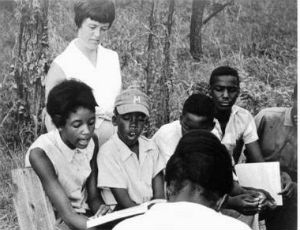Find out more about award winning biographer, Susan Goldman Rubin, July's Author of the Month. She remembers her childhood love of books and reading, how she got her start and the inspiration behind her new book Freedom Summer: The 1964 Struggle for Civil Rights in Mississippi.
Where did you get the idea for this book?
In the summer of 1964, civil rights groups in Mississippi recruited college students from across the United States to live with local black hosts, and open Freedom Schools and help register voters.
I vaguely remembered the events of 1964, when three civil rights workers were killed during the first week of the program. I mistakenly thought that Andrew Goodman, one of the three, had gone to Oberlin College, my alma mater. I had graduated in 1959, and many of my friends were active in the civil rights movement. The murders had greatly disturbed me. I wanted to know what actually happened and thought that this was an important period to research and write about. I discovered that few people knew much about it, yet it was a turning point in American history. I also wanted to pay tribute to leaders in the civil rights movement whose names were not well-known: Mrs. Fannie Lou Hamer, Bob Moses, Charles McLaurin, Dr. Leslie McLemore, Lawrence Guyot and Dave Dennis.
How did you research this book?
On my website, I am posting full transcripts of the interviews I conducted in person, on the phone, and through email with former Freedom Summer volunteers and civil rights veterans. This was a vital part of my research process. When I started researching Freedom Summer, I contacted the Oberlin Alumni Association, thinking that Andrew Goodman had been a student there. I found out he had gone to Queens College but many Oberlin students had participated in the program. An article had just been written about them for the alumni magazine and I contacted the author. She put me in touch with people she had interviewed, and one contact led to another. I also had the opportunity to speak with Rita Schwerner Bender, the widow of Mickey Schwerner, one of the three who was killed. That meeting set me on the right track for focusing my research on Mississippi and the work still to be done. I went to Mississippi and met with civil rights veterans, including Dr. Leslie McLemore and Charles McLaurin. Mr. McLaurin took me on a tour of important sites in the Delta where events had happened. I also was invited to attend a meeting of the Sunflower County Civil Rights Organization in Indianola, and I learned more about ongoing problems and concerns.
What was your favorite book when you were growing up?
I loved the Nancy Drew books because I enjoy mysteries and she was a spunky girl detective who drove a roadster (whatever that was), unheard of for a girl like me growing up in the Bronx. I was also fascinated by biographies of ballet dancers such as Pavlova and Nijinsky, and I adored the Mary Poppins stories and Noel Streatfeild’s series of “shoes” books: Ballet Shoes, Movie Shoes, Theater Shoes. I was already becoming an anglophile, and I still favor books by British authors set in England, Scotland, and Ireland.
How old were you when you started writing?
About thirty or thirty-two. I really wanted to be an illustrator. But I was a mother of three young children, living in a suburb of Los Angeles, and couldn’t afford to go to New York and show publishers what I thought was a portfolio and hopefully get assignments. So I started writing stories to give myself something to illustrate as a sample of my work. I sent editors a dummy, some pieces of sample art, and the text; and to my surprise they liked my writing as much, if not more than my illustrations. Even in rejection letters editors encouraged me to keep working at writing. I nearly sold my first picture book without my art,which I would have been glad to do. However, I wound up writing and illustrating my first three picture books.
What is your favorite word?
My favorite word is wonderful. I use it often, but every day I look up words in my unabridged dictionary to see what they really mean and how to use them properly.
What is your favorite book about Chicago?
My favorite book about Chicago is Sister Carrie by Theodore Dreiser. I read it when I was around eleven. My older brother gave it to me because he thought I was ready for good adult books. At that time in the Bronx, our branch of the public library was divided into two sections, one for children and one for adults. I had read everything of interest to me in the children’s side of the library, and the librarian finally let me go to the adult section. And my brother gave me more books. Another one about Chicago that I liked was The Jungle by Upton Sinclair that told about the horrors of the meatpacking business in the beginning of the twentieth century. My favorite children’s books about Chicago are almost set there. I’m thinking of Richard Peck’s A Year Down Yonder and A Long Way From Chicago. The kids in the novels are “Chicago people” but they visit their Grandma’s town and that’s where they have their adventures. The stories are wonderful! (There’s my favorite word.) Richard Peck is a superb writer and teacher.
Find out more about Susan Goldman Rubin and Freedom Summer: The 1964 Struggle for Civil Rights in Mississippi.



Add a comment to: Susan Goldman Rubin Q&A